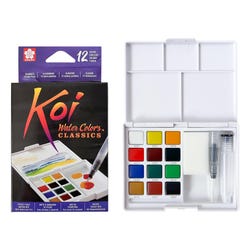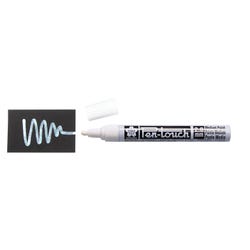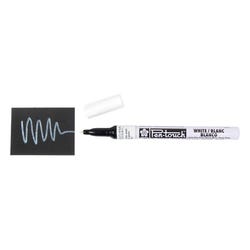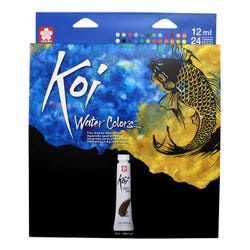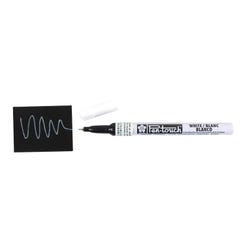Sketchy Business

Description
Lesson Plan and Artwork by Franz Spohn
Throughout the ages, artists have employed sketchbooks as part of their creative process. These sketchbooks are as unique as the artists themselves and are personal records—not only of their artwork and its development, but most often, also of their ideas, concerns, feelings, and observations of the physical and spiritual realms. This project will help students learn to use sketchbooks in a personal and influential manner in order to best express their own artistic visions.
Objectives
- Learn to trust their creative intuition and subjectivity
- Practice mixing additional colors to expand the color, tone, and shade of the basic 12 colors in the Koi® Water Colors set.
- Understand personal artistic visions through experimentation and sketching.
Supplies Needed
Sakura® Koi® Watercolors Pocket Field Sketch Box, Set of 12 Colors with Brush
Sakura® Koi® Watercolor Set, 12 ml, Assorted Colors, Set of 24
Sakura® Pigma® Micron® Waterproof Permanent Marker, Black, Pack of 6
Sakura® Pen-touch® Opaque Paint Marker, 2.0mm Medium Tip, White
Sakura® Pen-touch® Opaque Paint Marker, 1.0mm Fine Tip, White
Sakura® Pen-touch® Opaque Paint Marker, 0.7mm Extra Fine Tip, White
Sax® Blanc Books Hardcover Sketchbook, 28 Sheets, 6-1/4 x 8-1/4 Inches, Pack of 4
*Here are the supplies needed for this lesson plan for reference. Find a convenient carousel of shoppable products for this lesson below.
Standards
Standard #1: Generate and conceptualize artistic ideas and work.
Standard #2: Organize and develop artistic ideas and work.
Standard #10: Synthesize and relate knowledge and personal experiences to make art.
Instructions
Perhaps the most famous of sketchbooks that we have as example are those of Leonardo DaVinci. Contained in his volumes are anatomical studies, preliminary sketches for large drawings and paintings, explorations and diagrams of botanical species, and of course, the iconic “DaVinci man” where figure, square and circle are represented in a geometric approach to ideal proportions. Also included are mechanical engineering plans for flying machines to be built in the far future, as well as war machines and defenses that in fact were later built and proved extremely effective.
But also wedged among these noble and refined sketches are notably more down-to-earth examples, like doodles of kittens cavorting and lists of DaVinci’s daily clothing choices. Eugene Delacroix traveled extensively to foreign places and drew extensively in his sketchbooks. These images and details were used as references for his paintings of exotic cultures and places in the age before photography. Today, groups like the Urban Sketchers are out and about recording the details of living in the 21st century. William Blake, both an artist and a literary figure, included poetry in his sketchbooks. Picasso made studies of Old Masters in preparation for his radically different abstract paintings. Frida Kahlo included collaged elements, illustrations, and great amounts of text in her sketchbooks. And David Hockney’s sketchbooks are filled with a focus on ordinary objects to be used later as players in large paintings.
1
Using the combination of the Koi Water Color Set (with water-brush placed conveniently inside the box), Sakura Pigma Micron pens, and Sax’s Hardcover Sketchbook, drawing sessions can be done not only in the studio but out in the world.
2
The most important maxim to reinforce in this project is that in addition to all the serious art endeavors and goals, it should be FUN and fulfilling as an expression of creative activity. The project is not the “object,” but rather the development of artistic expression and the opening of the door to creativity and inquisitive exploration. The joy of drawing that we had as young artists must be kept alive and the sketchbook, in this instance, is the playground for the imagination. No rules, no pressure to draw in any particular style. Every bit of artistic exploration swirling and dancing across the page is a valuable lesson and integral to the process!
3
Creative activities and dopamine are closely connected, so low stress levels and a feeling of happiness and contentment in the process are beneficial psychological results—much needed by students in today’s world.
4
The Sakura Koi Water Color set Pocket Field Sketch Box is comprised of a basic selection of 12 colors from which many other colors, tones, and shades can be mixed using the palette surfaces that are part of the boxed set. The water-brush is collapsible and contained in the set. The reservoir is filled with water and the brush head is screwed onto the barrel (note: The threading mechanism is reversed, and rotation is counter-clockwise to tighten). If additional colors are desired, dots of tube watercolors can be placed on a sketchbook page or extra card stock, allowed to dry, and then used as an adjunct color source.
5
The 6-pen set of Sakura Pigma Micron Pens allows thick, emphatic outlines with the 08 tip, whereas the 005 provides the means for finest detailing. Crosshatching techniques can provide a mechanical approach to tone and value. Once dry, these markers are permanent, and watercolor can be applied after the ink has set.
6
The cover can also be a part of the personality of the sketchbook, and a variety of materials can be used to create an introduction image to each artist’s book. The assemblage of sketchbook and drawing tools create the ideal take-along studio on the go. Creative activity can always be at the fingertips, and will provide young artists the opportunity to fully develop and thereby understand more clearly their personal creative and artistic vision.



